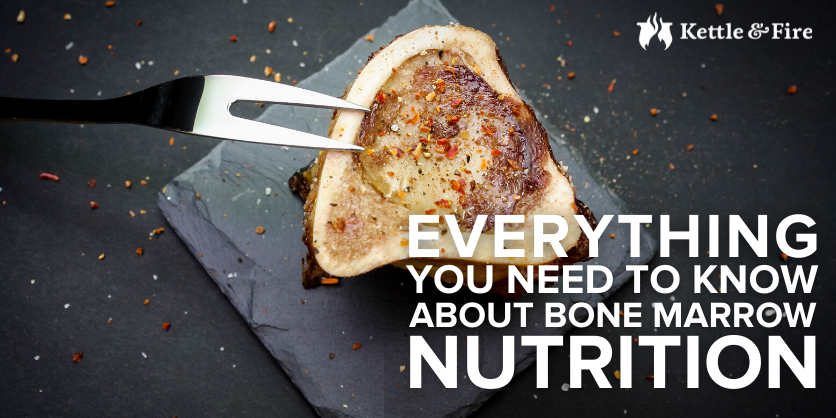Bone Marrow 101

THE BODY’S REGENERATION STATION
In modern cuisine, animal bones were once considered inedible waste. These “scraps” were largely overlooked and destined for the garbage can, along with paper napkins, decorative trimmings, and other uneaten bits…never to be thought of again.
That is, until they finally started getting the recognition they deserve. Now, bone marrow is not only considered a delicacy – spared and served as a hot-ticket item at restaurants worldwide – but it’s growing in popularity in even the smallest of kitchens due to its incredibly high nutrient value.
Below, you’ll learn more about bone marrow, why it’s so good for us, and how to incorporate it into your diet (without wining and dining in some extravagant setting).
Let’s get to the meat of things…
What Is Bone Marrow?
To put it simply, bone marrow is the fatty tissue found in the center of bones, with the greatest quantities typically found in the leg (specifically the femur).
In birds and mammals, bone marrow is where blood cell production happens and living bone marrow contains stem cells, which have incredible regenerative characteristics. Stem cells produce both white and red blood cells, as well as platelets, which all help carry oxygen through the body, fight infection, and help with blood clotting.
Miraculously, human bone marrow contributes to the production of about 500 billion blood cells per day! (Wow. We suddenly feel very lazy with respect to our day jobs.)
It might sound kind of scientific and unappetizing, but trust us when we say: eating bone marrow is actually a delicious way to support your body’s overall health in a major way.
The Culinary History of Bone Marrow

People consumed bone marrow long before it found its place in modern American cuisine, particularly in Europe and Asia. There is some evidence that early hominids collected animal bones specifically for the nutrients found in marrow. Similarly, indigenous people of Canada and the northern US noshed on marrow for its nutrients and ability to aid in proper digestion.
Now considered a special treat in traditional cuisine across the globe, bone marrow appears on restaurant menus all over the world.
Slightly buttery in taste, it’s loved by chefs and foodies alike for its tenderness, versatility, and ability to adopt the “less is more” adage; in other words, you can eat less of it to get more nutrients than a huge hunk of meat.
Preparation happens in a number of ways. Bone marrow can be roasted and spread on toast, like butter or a pâté, or consumed in soups and stews. It can be found in traditional Italian dishes like ossobuco, in Vietnamese pho, or even as a filling in Mexican tostadas. With the rising interest in ancestral health, many people seek out bone marrow for its nutrient density — flavor being an added benefit.
Health Benefits of Bone Marrow

From a macronutrient standpoint, bone marrow is made up of 97% fat, with a little protein and no carbohydrates. From the 1970s through 1990s, bone marrow was criticized for its high fat content, but we know so much more about “good fats” vs “bad fats” today.
Like bone broth, people consume marrow for the healthy fats, amino acids, vitamins, and minerals it contains.
The benefits of both broth and bone marrow are not all that different: helping boost the immune system, supporting a reduction in inflammation associated with joint pain, and aiding in weight management.
That said, there are significant health benefits specific to bone marrow alone…
Marrow May Help Restore White Blood Cells
On little more than a hunch, Dr. Astrid Brohult, a Swedish oncologist, gave leukemia patients bone marrow soup to help their own bone marrow resume normal function (1). While results were somewhat inconsistent for this initial experiment, some patients did experience incredible improvements, such as: the return of their white blood cell count, along with a boost in energy.
A full decade later, Brohult’s husband, a biochemist, believed he discovered the ingredient responsible for white blood cell production. Bone marrow contains a group of compounds called alkylglycerols (AKGs), which are immune-boosting lipids also found in human breast milk.(1)
And while more research is being done on the topic, the things we already know to be true about bone marrow are nothing short of fascinating.
Marrow Can Help Heal the Digestive Tract
In the field of medicine, specifically in more holistic circles, bone broth has been “prescribed” as a means of helping and healing the digestive tract. Since real bone broth is slow-simmered for hours on end , nutrients are extracted from the marrow as the bones break down (without burning them).
Many nutritionists and medical professionals have found that bone marrow is beneficial and can reduce symptoms for those who have a gluten intolerance, Celiac’s disease, leaky gut, or IBS (irritable bowel syndrome).
Bone marrow helps reduce inflammation by sealing the stomach lining and thereby reducing discomfort and improving overall gut health.
Marrow Could Decrease the Risk of Various Health Issues
A University of Michigan study showed that the fat tissue in bone marrow contains significant amounts of the hormone adiponectin, which supports insulin sensitivity, breaks down fat, and may help decrease the risk of cardiovascular disease, diabetes, and obesity-associated cancer.
Individuals who have issues with weight management and obesity have been shown to have the lowest levels of adiponectin. It’s believed that the more lean an individual becomes, the more adiponectin they have. (2)
Marrow Can Have More Vitamins & Minerals Than Meat

Bone marrow is an incredibly nutrient-dense food, sometimes containing more vitamins and minerals than meat.
In one study, bone marrow was found to have 4x the amount of vitamin E than the actual meat! It was also found to have twice the amount of both vitamin A and B1. (3)
Additionally, the highest concentrations of calcium were found in bone marrow compared to other parts of the animal, including meat, tallow, and liver. (3)
Buying & Eating Bone Marrow
Thankfully, you don’t have to revert to the hunter-gatherer techniques of our ancestors to receive ancestral health benefits. Today, bones containing marrow can easily be purchased from a local farmer, farmers market, and various health food stores.
Pro Tip: while other animal bones do contain marrow, beef bones offer the best bang for your buck due to the size of the bones.
If you plan to consume bone marrow through soups or stews, you can purchase whole bones. However, if you plan to eat the marrow straight from the bone, you will save considerable time and energy by asking your butcher to split the bones in half. This offers easy access to the marrow within the bone (otherwise, you’ll have to pluck it out with a pair of small tongs).
The price of bone marrow will vary depending upon the quality you buy. Grass-fed bones from healthy animals are definitely recommended by our team for your overall health, but these do come at a premium price point.
Many people enjoy roasting the bones in the oven and serving the fatty marrow with some sort of marmalade. Others spread the marrow across crackers or toast.
Ways to Get More Bone Marrow Nutrients

Not sure you want to cook your own marrow or spend the money on expensive restaurant cuisine to get it? We get it! Luckily for you: Health is in Our Bones.
Kettle & Fire Bone Broth is made using high quality ingredients, like beef bones from grass-fed, grass-finished cattle. And one of the easiest ways to get the same nutrients that you can find in bone marrow is to simply drink more bone broth.
___________________________________________________________________
Resources:
